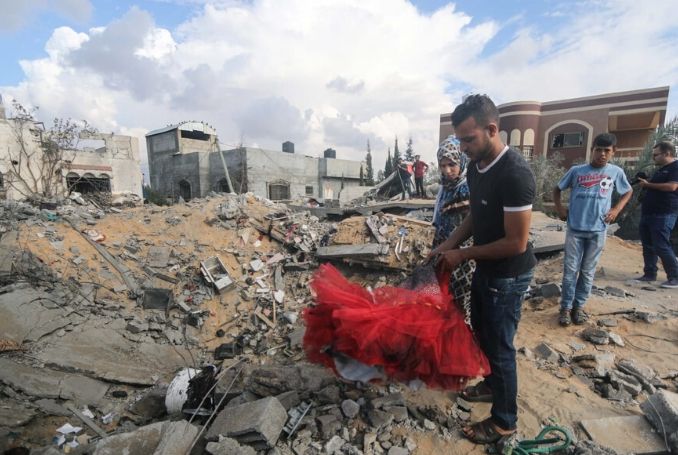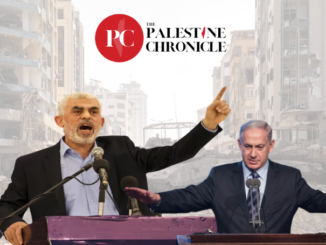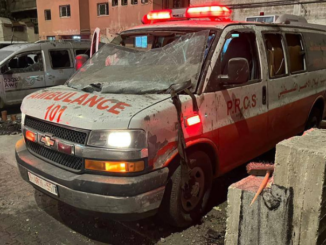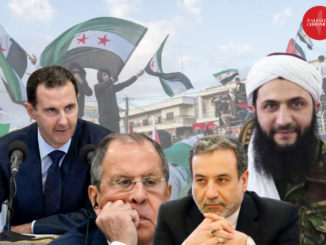
Gaza has always been the exception throughout history. Starting from mighty Samson to the Intifadas, Gaza was always there, regardless of the challenges, leaving its own mark on history and reminding everyone it in no way could be bypassed.
The biblical story of mighty Samson took place in Gaza, where, according to the narrative, he got married to Delilah, a Philistine, who kept nagging on him until he told her the secret of his strength, his long hair. One night, Delilah cut off his hair and handed him over to the Philistines, who tied him to the pillars of a pagan temple in Gaza, largely believed to have existed on the current site of al-Omari Mosque, which too used to be the St. John’s Cathedral. Samson, the tragic hero made a final prayer to gain some strength and when he stood up toppling the temple on himself and on thousands of Philistines who were inside.
After the population of Palestine converted to Christianity, Gaza was one of the last cities in Palestine to do so, which prompted the reputation of the people of Gaza as stubborn. When the British tried to capture Gaza during the First World War, it took them three attempts and thousands of dead soldiers to do so. Today, they are buried in the British Cemetery in Gaza, one of a few places in the coastal enclave that is green and spacious.
In 1948, when Israel razed to the ground nearly 532 Palestinian towns and villages, Gaza stood to its invaders, and it was not captured. It became home to more than 200,000 new refugees. Many of Gaza’s refugees attempted to return back to their villages following 1948, with Israel calling them infiltrators and bombing refugee facilities and hospitals in Gaza to scare refugees planning to return home.
In 1949 when Israel and Egypt signed an armistice agreement around 150 sq km of land in the Auja al-Hafir region was ceded to create a demilitarized zone. However, today Israel controls this area, effectively annexing it as part of Israel in 1967.
Israel captured Gaza for six months in 1956 following the outbreak at the Suez Canal. Palestinians launched many military attacks on Israeli forces stationed at the Gaza fence. That same year Israel attacked the small southern Gaza village of Abasan in Khan Yunis, killing 275 Palestinians. There have been repeated confrontations at this site over the last six decades. This is where the commander in an Israeli intelligence unit posing as Palestinian humanitarians was killed in 2018 after locals became suspicious and their cover was blown.
After each war, Israel has moved to prevent Palestinian refugees in Gaza from returning home, including laying landmines around armistice lines and inside Palestinians territory. Errant mines continue to kill Palestinians inside Gaza and the West Bank decades after their planting. But this didn’t deter thousands of Palestinian refugees from attempting to do so, very often costing them their own lives.
In the subsequent years leading its capture in 1967, Gaza has played an important role in Palestinian history, where groups of fighters known as the fedayeen trained under Egyptian forces who controlled Gaza up until 1967. In 1967, Gaza was finally captured by Israel along with the West Bank, East Jerusalem, and the Golan Heights.
Israelis have always viewed Gaza and its population, mostly refugees, as non-existent.
One time, an Israeli told me that a radio station asked Israelis “What to do with Gaza?” and one of the audiences suggested “turning it into the biggest parking lot in the world.” This is how Israelis have always viewed Gaza, a parking lot, or a hell as the Hebrew curse goes “Go to Gaza,” (lekh le’aza) instead of “Go to hell,” (lekh leazazel).
Israeli soldiers have always sought entrainment in Gaza. During the first Palestinian Intifada, an Israeli patrol unit stopped my father at the entrance of our neighborhood in the al-Nusairat refugee camp and asked him to dance. My father, knowing if he said no, he will be beaten or perhaps shot, agreed to their request, but asked them to put their guns aside and clap for him. Once they did, he picked up his slippers and ran into an orange orchard, where he climbed a high tree. They kept looking for him without a success and a rumor broke out in the refugee camp that he was killed. My grandmother started crying for him and when sunset drew closer, my father made use of his beautiful voice to communicate with his family by making the call for prayer. Upon hearing his voice, my grandparents finally felt assured.
Today, people in Gaza are struggling to afford the basics. And all of them fight to keep their dignity alive, with many of them becoming tragic heroes, just like Samson. Today, I see Samson in the eyes of Mahmoud Shokor, 25, a young man from Gaza, who suffered a serious injury at a construction site. After 23 days in a coma, Mahmoud woke up, unable to speak and with the right side of his body paralyzed. His father sent a plea of help from his hospital bed asking for help to cover Mahmoud’s medical bills.
All he wanted is to keep him alive in dignity as he lost his eldest son Ayman in 2014 to Israeli random shelling, at the age of 25 too. Mahmoud’s father, Adnan, worked in Israel for many years when he was young, but Israel’s siege and shells made him live through the killing of his eldest son and now the serious injury of his other son without being able to provide continuing treatment.
In November, Gaza saw the killing of 34 Palestinians after a bombing campaign by Israel that was started with the killing of Islamic Jihad commander Baha Abu al-Ata. Following a ceasefire that was brokered by Egypt, hundreds of Palestinians took to the streets calling for avenging the deaths of the 34 Palestinians, including the Sawarka family of eight people, mostly children, who were killed in their sleep by an Israeli strike.
The Israeli army later said the killing of the family was a “mistake.” The Israeli army claimed it thought the house was empty, but if it thought so, why to target an empty house in the first place? Does the Israeli army think Palestinians in Gaza buy into this narrative anymore? How many mistakes will it take the Israeli army before it stops bombing Gaza altogether? Or is Gaza the exception?
(A version of this article first appeared in Mondoweiss)
– Yousef M. Aljamal is a Palestinian who grew up in Al-Nuseirat refugee camp in the Gaza Strip. He is a PhD candidate at the Middle East Institute at Sakarya University in Turkey. He contributed this article to the Palestine Chronicle.







